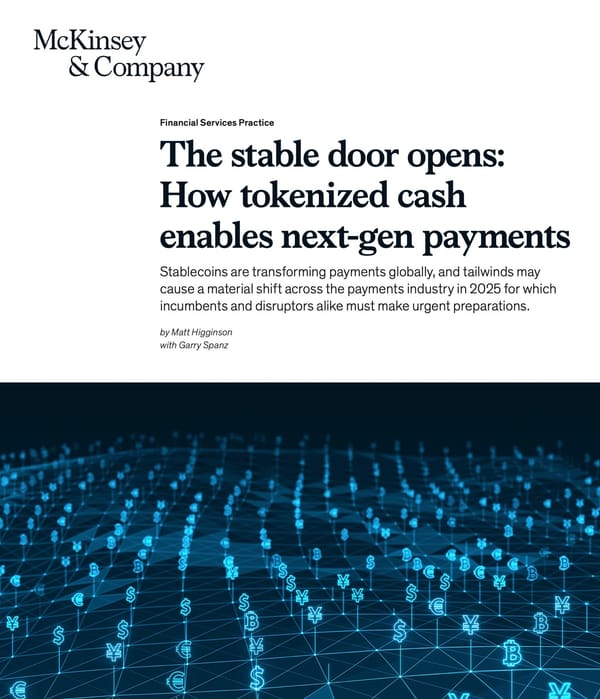Source / Author: McKinsey & Company — Financial Services Practice (Matt Higginson and Garry Spanz)
Publication Date: July 2025
Document with my annotations:
Focus:
This McKinsey report analyzes how tokenized cash and stablecoins are reshaping global payments infrastructure, accelerating settlement, and redefining liquidity management. It outlines technological, regulatory, and institutional developments positioning 2025 as a potential inflection point for large-scale stablecoin adoption and tokenized money.
⸻
Key Insights
• Stablecoin transaction volume exceeded USD 27 trillion in 2024, growing 10× in four years—yet still represents less than 1% of global money flows.
• Tokenized cash now exists in three main forms: CBDCs, private stablecoins, and bank-issued tokenized deposits—each offering instant settlement and programmable compliance.
• Stablecoins outperform legacy payment rails on speed (instant vs. 1–5 days), cost (<$0.01 vs. $15–$50 per transaction), availability (24/7/365), and transparency (on-chain traceability).
• Circulating stablecoin supply has doubled to USD 250 billion, with forecasts reaching USD 400 billion by end-2025 and USD 2 trillion by 2028.
• Use cases span cross-border payments, remittances, capital market settlement, and treasury management, as major banks (e.g., JPMorgan, Citi, UBS) experiment with tokenized deposits.
• Regulation is catching up: the EU’s MiCA, UK’s FSMA, and the US GENIUS Act (2025) establish reserve, audit, and licensing standards that legitimize stablecoins as “digital cash.”
⸻
Notable Figures
• Stablecoin transaction volume: USD 27 trillion (2024)
• Circulating stablecoins: USD 250 billion (mid-2025) → USD 2 trillion (2028 forecast)
• Remittance share via stablecoins: ≈3% of USD 200 trillion in cross-border payments
• Bank tokenized money examples: JPM Coin, Canton Network, Partior
• Settlement cost comparison: <$0.01 vs. $15–$50 per transaction
⸻
Analyst Take
McKinsey’s analysis identifies tokenized cash as the most transformative evolution in payments since SWIFT. Stablecoins, tokenized deposits, and CBDCs are converging toward a programmable, interoperable ecosystem that collapses global settlement times from days to seconds. The paper underscores 2025 as a turning point: with regulatory clarity, maturing blockchain infrastructure, and institutional participation, tokenized money is transitioning from concept to core financial infrastructure. For financial institutions, readiness now defines relevance—the winners will be those who integrate stablecoin rails into treasury, liquidity, and client payment systems.
⸻
Citation:
Source: McKinsey & Company, “The Stable Door Opens: How Tokenized Cash Enables Next-Gen Payments,” July 2025. https://www.mckinsey.com

